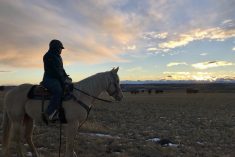Did you know that there is a direct correlation between the profitability of a ranch and the length of its grazing season? A few issues ago, Don Campbell wrote a very good article giving an example of how a farm could make more profit by running fewer cows. Lowering cow numbers and lengthening the grazing season gave the potential for more profit. It was a fantastic article.
If this is true, wouldn’t it be nice if we all had a grazing expert on our farm? Someone we could rely on who understood the concepts and knew how to design a good grazing cell. Maybe they would understand a grazing chart and be able to develop a record keeping system that would help us understand our pasture yields and gross margins.
Read Also

Reintroducing fire to Saskatchewan pastures
Pastures evolve over time. Woody plants and shrubs, which cattle can’t eat, may encroach on natural grasses. Invasive species, such…
Wait, you can! It can be you! All it takes is a little education and you can be your own grazing manager. You do not need to spend seven years in university and become a range-management scientist. Did you know that academia does not have a monopoly on knowledge? It takes about three days of education and a desire to keep learning. Do you want to improve the profitability of your operation?
Here’s a very simple outline of what it takes to be your own grazing manager. I call it my 10-step grazing plan.
1. Graze period — Managing to reduce overgrazing by preventing the “second bite.”
2. Rest period — Managing to provide adequate root energy recovery.
3. Stock density — Increases utilization and improves manure distribution.
4. Animal impact — Improve rejuvenation, the water cycle and decomposition.
5. Water holding capacity — Reduce run off, evaporation and increase water holding capacity.
6. Sunlight harvesting — Optimal sunlight harvesting by managing the stage of growth.
7. Recycled nutrients — An understanding of nutrient recycling through the animals and into the soil.
8. Soil organisms — Develop management strategies to encourage soil organic life.
9. Stocking rate — Calculated in ADA and based on estimated or actual data.
10. Forage selection — Using species selection to match the environment.
Now as a grazing manager, we also need to develop a workable cell design. Here is my 10-step cell-design process.
1. Personal restraints — Accommodating for personal issues.
2. Herd restraints — Understanding herd requirements.
3. Physical land restraints — Dealing with physical land issues.
4. Separate forage types — To reduce selective grazing.
5. Manage riparian areas — Manage for sustainability and environmental health.
6. Water systems — Understanding water systems and limitations.
7. Protect water sources — maintaining herd and environmental health.
8. Plan for animal movement — Rotational planning to lower both animal and manager stress.
9. Convenience for winter management — Accommodating for winter grazing strategies.
10. Existing fencing — Incorporating existing fence if possible.
I would also recommend that as a manager you learn how to use a grazing notebook. This is a pocket-sized field record-keeping system designed to transfer information from the pasture to your grazing chart. It should include some drawings or maps of your cell design.
The Grazing Chart is an invaluable tool on my ranch and every grazing manager should learn how to use one. A few months ago I wrote an article about grazing charts and I would recommend you find one and learn how to use it. It is a means of not only pasture planning, but a record keeping system designed to calculate yield and provide annual production records for individual pastures and paddocks. To understand if a pasture is profitable or not, you need to calculate the yield. That is what a grazing chart can provide for you.
I know it is winter and grazing is the last thing on your mind, right? Why? Because you are too busy feeding! That is my point exactly. I hear producers complain about two things the most. They don’t have enough time and they don’t have enough money. By lengthening your grazing season, it is amazing how it gives you more of both. There are quite a few schools, conferences and seminars being offered this winter that will give you a positive first step in improving the profitability of your operation. It will be an investment in your farm. Be ready next spring to turn some profitability back into your operation. Improve your business. Improve your grazing skills. Be a manager… and start with the management of the manager!
SteveKenyonrunsGreenerPasturesRanchingLtd.inBusby,Alta., www.greenerpasturesranching.com, 780-307-6500,email
















